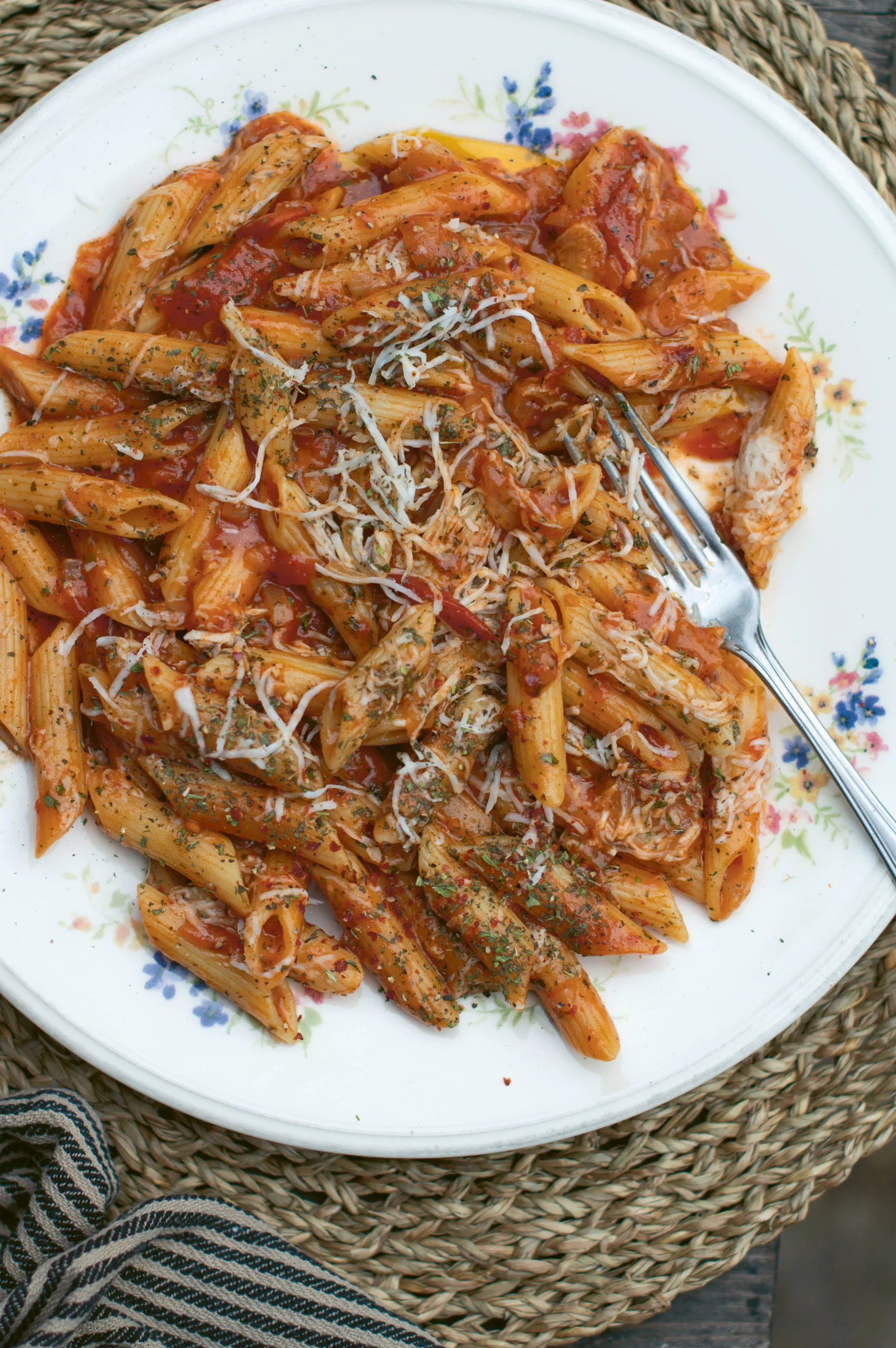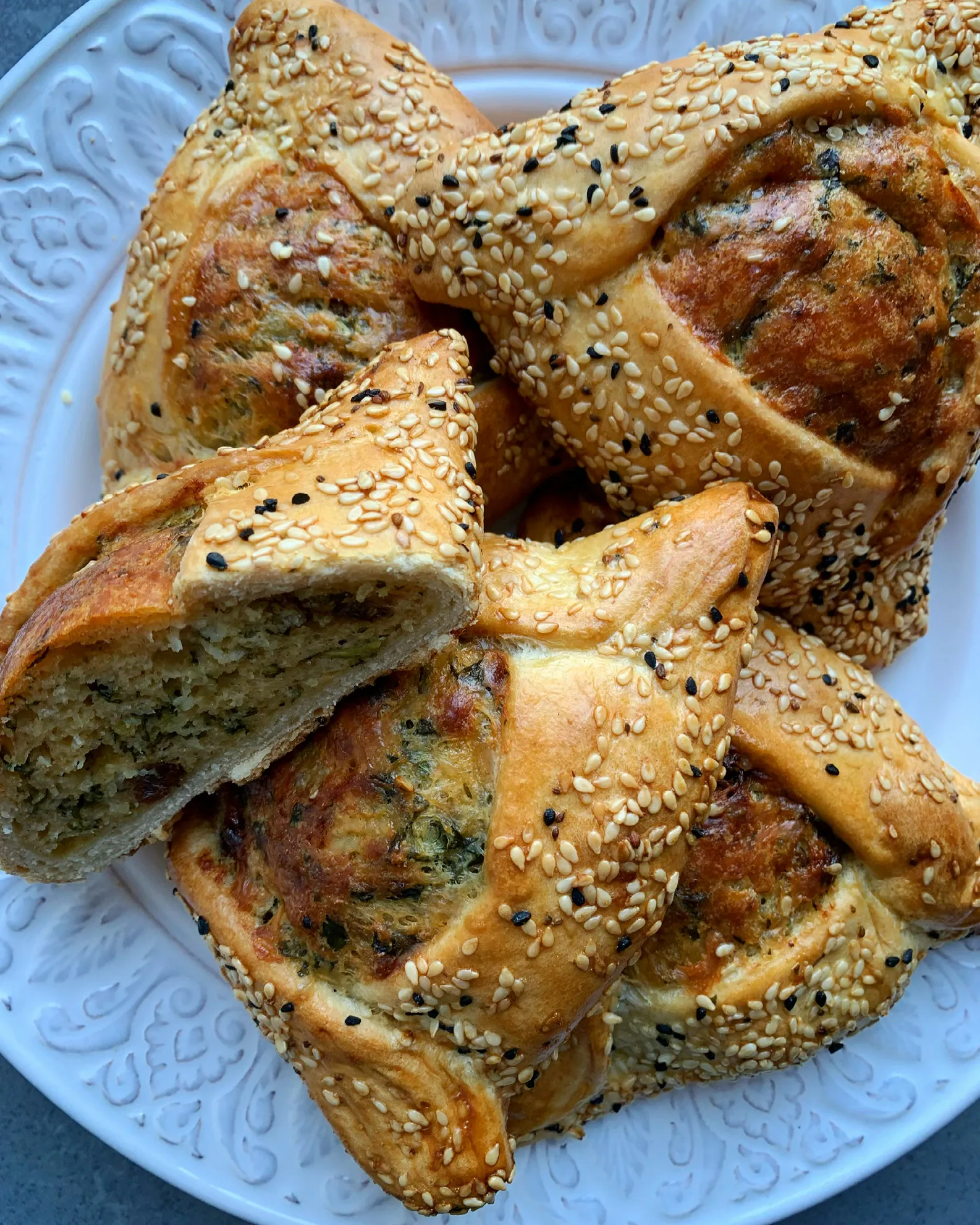Meliz Berg recalls reading Shakespeare’s Othello and the description of Cyprus as a melting pot where East meets West in the middle of the Mediterranean Sea. Just below Turkey, above Africa, and neighboring Syria, Lebanon, and Greece, the island became the crossroads of cultures, armies, and travelers, making for a melange of flavors when it comes to Cypriot cuisine.
Influenced by Greek and Turkish cooking, Cyprians use herbs like coriander, which was brought over by Asian travelers. One of Berg’s favorite ingredients is halloumi, a spongy cheese that is both eaten fresh and cooked in pastas, salads, and baked goods.
Her cookbook is Meliz’s Kitchen.

“Once you’ve tried freshly-grated halloumi and dried mint on pasta, it’s really hard to go back,” says Meliz Berg. Photo by Meliz Berg.
Hellimli Domatesli Magarına
One-Pot Halloumi & Tomato Pasta
Serves 4-6
This is a one-pot pasta recipe that begins with a delicious tomatoey base and, in true Cypriot fashion, is finished off with a liberal coating of grated Hellim (halloumi) and dried mint. Sweet caramelized onions, cinnamon, and bay leaves give the dish its essential Cypriot umami—this is a dish that is perfect served on its own, but one that goes well with a fresh and simple portion of Salata (Salad, page 54) on the side.
Ingredients
- 3 tbsp olive oil
- 2 onions, finely chopped
- 4 garlic cloves, finely grated
- ½ tsp paprika
- 1 tsp ground cinnamon
- ½ tsp sea salt flakes
- 1 tsp cracked black pepper, plus extra to serve (optional)
- 6 tsp dried mint, plus extra to serve (optional)
- 4 tbsp tomato paste
- 14 oz (400 g) can chopped tomatoes
- 1 chicken or vegetable bouillon cube
- 2 cups (500 ml) boiling water
- 2 bay leaves
- 10½ oz (300 g) penne pasta
- 5½ oz (150 g) halloumi cheese, grated, plus extra to serve (optional)
- 1 tbsp fresh flat-leaf parsley, finely chopped
- Extra virgin olive oil, to serve
Instructions
-
Heat the olive oil in a large nonstick pot over medium heat and add the onions, cooking them for 12–15 minutes until caramelized. Add the garlic and stir for a minute or two, then add the paprika, cinnamon, salt, ½ teaspoon of the black pepper, and 2 teaspoons of the dried mint and stir well. Add the tomato paste and the chopped tomatoes, stir well, and reduce the heat down to the lowest simmer. Let everything cook for 2–3 minutes while you get the stock ingredients ready. Keep checking the pot and giving it the occasional stir to make sure it doesn’t catch on the bottom of the pot.
-
Add the bouillon cube to a large measuring jug and dissolve fully in the measured boiling water. Fill the empty can of chopped tomatoes with cold water, add to the jug, stir, then top up with as much water as necessary to bring the stock mixture up to 4¼ cups (1 liter).
-
Add the bay leaves and the pasta to the pot, stir everything together, then pour in the stock. Stir the pasta well, bring to a boil, then reduce to a low–medium simmer for 12–15 minutes.
-
In a bowl, combine the grated halloumi with 2 teaspoons of dried mint and the remaining half teaspoon of black pepper.
-
Once the pasta has cooked (there should still be some juices in the pot, but the sauce should have reduced down), carefully pour it into a large serving dish, stir through the parsley, the halloumi, and the remaining 2 teaspoons of dried mint. Drizzle over some extra virgin olive oil to serve and garnish with extra halloumi, dried mint, and black pepper if desired

Pilavuna is a traditional pastry made by Greek Cypriots at the end of Easter and by Turkish Cypriots during Ramadan. Photo by Meliz Berg.
Pilavuna
Cheese & Raisin Pastries
Makes 14
Pilavuna (or Flaounes) are beautiful Cypriot cheese-and raisin-filled pastries, with a very unique flavor combination typical of Cyprus. Historically made by Greek-Cypriots to mark the end of their fasting period and the start of their Orthodox Easter, they are also traditionally made by Turkish-Cypriots to mark the end of Ramadan and to signal the start of Ramazan Bayramı (Eid-al-Fitr).
The sweet, salty, cheesy, minty mix is just heavenly. I freeze them and heat them up for breakfast when I fancy something sweet and salty, and the kids love the ritual of making these with me; however, I think they love eating them just that little bit more!
Ingredients
For the filling
- 9 oz (250 g) halloumi cheese, finely grated
- 9 oz (250 g) Pecorino, finely grated
- 2 cups (50 g) fresh mint leaves, finely chopped
- 5 tbsp semolina
- 3 tbsp all-purpose flour
- 1 tbsp baking powder
- 1 tbsp sugar
- Scant 1 cup (125 g) raisins
- ¼ tsp ground cinnamon
- ¼ tsp mahleb
- 8 large eggs
For the dough
- 6 cups (750 g) all-purpose flour, plus extra for dusting
- 1 tbsp baking powder
- 1 tsp fine sea salt
- 5 tbsp (75 g) unsalted butter
- 2⁄3 cup (150 ml) boiling water
- 1 large egg
- 2 tbsp thick plain yogurt
- 1 tsp sugar
- Olive oil, for greasing
For the coating
- 3⁄4 cup (100 g) sesame seeds
- 2 tsp nigella seeds
- 1 tsp aniseed
- 1⁄3 cup (90 ml) boiling water
- 1 egg
Instructions
-
To make the filling, put the halloumi and Pecorino cheeses into a large bowl. Add the mint leaves to the bowl along with the semolina, all-purpose flour, baking powder, sugar, raisins, cinnamon, and mahleb. In a separate bowl, whisk the eggs together until frothy and add them to the cheese mixture. Gently stir everything together until fully combined, then cover the bowl with plastic wrap, and chill in the fridge for 4 hours.
-
Now make the dough. Sift the flour, baking powder, and salt into a large bowl and set aside. Melt the butter in a large heatproof measuring jug with the boiling water, then top up with another 2⁄3 cup (150 ml) of cold water. In another jug or bowl, whisk the egg with the yogurt and sugar and gently pour it into the butter. Mix everything together and top up with cold water to bring the entire contents of the jug up to just over 2 cups (500 ml). Make a well in the center of the flour mixture, and slowly start to pour in the liquid ingredients, using a large spoon to bring everything together. Turn the dough out onto a floured surface and knead for a few minutes until smooth.
-
Spread a little olive oil in the bowl and place the dough in it, cover with a tea towel, and leave for 30 minutes, or at least until the dough has puffed up a little.
-
Remove the filling mixture from the fridge so that it can come to room temperature.
-
On a large baking tray, mix the sesame and nigella seeds, aniseed, and boiling water and set aside so that the seeds soften and swell a little. Whisk the egg in a bowl and set aside.
-
Line two large baking sheets with parchment paper. Preheat the oven to 425°F (220°C).
-
Remove the dough from the bowl and divide it into 14 equal pieces— each piece should weigh approximately 3 oz (85 g). On a clean work surface, roll each piece into a smooth ball using the palm of your hand. Now start to roll out the dough into circular discs, gently pushing down and out with the rolling pin, and rotating at a 45° angle each time you do until your disc is 6 inches (16 cm) in diameter, dusting with a little flour as you go, if necessary. If you have space, roll out all the discs at once; if not, you can roll, coat with seeds, fill, and seal each pilavuna as you work.
-
Gently press one of the discs into the seed mixture so that the seeds stick to the dough. Lay the seeded side on the work surface, and place approximately 2¾ oz (80 g) of the filling in the center. Fold up the sides of the disc in thirds to create a triangular parcel, firmly pressing down the corners of the triangle with a fork, while leaving some of the filling exposed in the center. Place the parcel on one of the prepared baking sheets (usually four pilavuna will fit on each sheet and have two sheets in the oven on rotation at any one time). Once you have eight pilavuna ready, put the sheets in the oven and bake for 20–25 minutes until golden brown. By the time they’re golden, the remaining pastries will be ready for the oven. Place on wire racks to cool. These freeze well and can be wrapped in foil and heated in the oven or microwaved from frozen.

Meliz Berg describes the Cyprian flavor palette as one of simple food with quintessential fresh flavors and slow-cooked meat dishes, heavily laden with lemons and herbs. Photo by Dan Jones.

Meliz’s Kitchen is a compilation of traditional, comforting recipes celebrating the intersection of cultures. Photo courtesy of Interlink Books.
